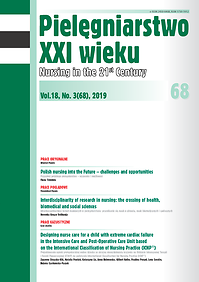Return of spontaneous circulation and heart rhythm during the first analysis of the heart electrical activity
DOI:
https://doi.org/10.2478/pielxxiw-2019-0021Keywords:
cardiac arrest, esuscitation, return of spontaneous circulationAbstract
RETURN OF SPONTANEOUS CIRCULATION AND HEART RHYTHM DURING THE FIRST ANALYSIS OF THE HEART ELECTRICAL ACTIVITY
Introduction. Return of spontaneous circulation (ROSC) of a patient with cardiac arrest is the main goal of carrying out cardiopulmonary resuscitation.
Aim. Evaluation of frequency of return of spontaneous circulation depending on the heart rhythms in the first moment of heart electrical activity.
Material and methods. Analysis of 105 cases of sudden cardiac arrest in out-of-hospital conditions on the premises of Brzozow Emergency Medical Service from September 2016 to the end of February 2018. The data was collected from intervention medical cards and medical rescue procedure cards. Statistical analysis was carried out using STATISTICA software. Statistical significance was assumed to be p<0.05.
Results. Sudden cardiac arrest in the analysed group applied to 62.9% of men. Return of spontaneous circulation was achieved only in 16 out of 105 cases (15.2%) of sudden cardiac arrest. The analysis has indicated that ROSC was successful among 66.67% of patients, who during the first analysis of the rhythm, represented cardiac arrest in VF/pVT, what constituted 75% of all ROSC cases in the analysed group. Comparison between ROSC and rhythm during the first evaluation of the rhythm showed statistical significance (p=0.00). Statistical significance was also shown in the relationship between ROSC and the average age of the patient (p=0.0155).
Conclusions. Sudden cardiac arrest, when diagnosed in the first analysis of the rhythm VF/pVT, has bigger chances for return of spontaneous circulation than it has in other rhythms.
References
1. Kamińska K, Krzemińska S. A nursing care of patients after cardiac arrest in the course of myocardial infarction. Journal of Education, Health and Sport. 2018;8(7):345-356.
2. Soar J, Nolan JP, Böttiger BW, et al. European Resuscitation Council Guidelines for Resuscitation 2015 Section 3. Adult advanced life support Resuscitation. 2015;95:100-147.
3. Perkins GD, Olasveengen TM, Maconochie I, et al. European Resuscitation Council guidelines for resuscitation: 2017 update. Resuscitation. 2018;123:43-50.
4. Sondergaard MM, Nielsen JB, Mortensen RN, et al. Associations between common ECG abnormalities and out-of-hospital cardiac arrest. British Medical Journal. 2019;6.
5. Gräsner JT, Bossaert L. Epidemiology and management of cardiac arrest: what registries are revealing. Best Pract Res Clin Anaesthesiol. 2013;27(3):293–306.
6. Nadolny K, Bujak K, Kucap M, et al. The Silesian Registry of Out-of-Hospital Cardiac Arrest: Study design and results of a three-month pilot study. Cardiology Journal. Published online: 2018-11-14; DOI: 10.5603/CJ.a2018.0140.
7. Keller SP, Halperin HR. Cardiac arrest: the changing incidence of ventricular fibrillation. Current Treatment Options in Cardiovascular Medicine. 2015;17(7):392.
8. Strömsöe A, Svensson L, Axelsson AB, et al. Improved outcome in Sweden after outof-hospital cardiac arrest and possible association with improvements in every link in the chain of survival. European Heart Journal. 2015;36(14):863-871.
9. Hulleman M, Zijlstra JA, Beesems SG, et al. Causes for the declining proportion of ventricular fibrillation in out-of-hospital cardiac arrest. Resuscitation. 2015;96:23-29.
10. Wolbinski M, Swain AH, Harding SA, Larsen PD. Out-of-hospital cardiac arrest patient characteristics: comparing ventricular arrhythmia and Pulseless Electrical Activity. Heart Lung and Circulation. 2016;25(7):639-644.
11. Cebula G, Osadnik S, Wysocki M, et al. Comparison of the early effects of out-ofhospital resuscitation in selected urban and rural areas in Poland. A preliminary report from the Polish Cardiac Arrest Registry by the Polish Resuscitation Council. Kardiologia Polska. 2016;74(4):356-361.
12. Gräsner JT, Meybohm P, Lefering R, et al. ROSC after cardiac arrest the RACA score to predict outcome after out-of-hospital cardiac arrest. European Heart Journal. 2011;32(13):1649-1656.
13. Filip D, Górski A, Wojtaszek M, Ozga D. Analiza funkcjonowania zespołów ratownictwa medycznego w rejonie operacyjnym Wojewódzkiej Stacji Pogotowia Ratunkowego w Rzeszowie w 2012 roku. Anestezjologia i Ratownictwo. 2016;10:278-285.
14. Rosell-Ortiz F, Escalada-Roig X, Fernandez Del Valle P, et al: Out-of-hospital cardiac arrest (OHCA) attended by mobile emergency teams with a physician on board. Results of the Spanish OHCA Registry (OSHCAR). Resuscitation. 2017;113:90-95.
15. Hiltunen P, Kuisma M, Silfvast T, et al. Regional variation and outcome of out-ofhospital cardiac arrest (OHCA) in Finland – the Finnresusci study. Scandinavian Journal of Trauma, Resuscitation and Emergency Medicine. 2012;20:80.
16. Nadolny K, Szarpak L, Gotlib J, et al: An analysis of the relationship between the applied medical rescue actions and the return of spontaneous circulation in adults with out-of-hospital sudden cardiac arrest. Medicine (Baltimore). 2018;97(30): e11607.
Published
Issue
Section
License
Copyright (c) 2019 Authors

This work is licensed under a Creative Commons Attribution-NonCommercial-NoDerivatives 3.0 Unported License.




